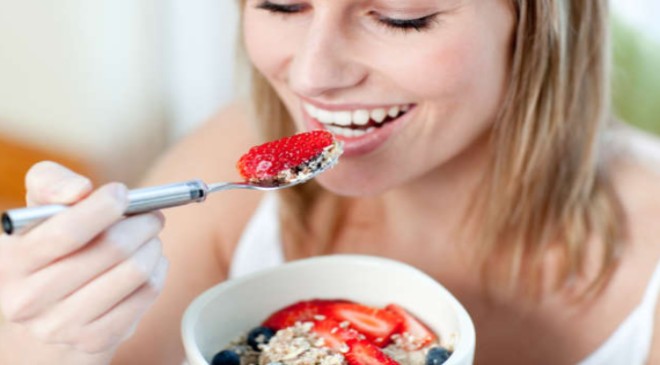Reviewed by Dietitian Emily Lachtrupp, M.S., RD
You have probably heard that protein-rich snacks are the ticket to keeping you full and satisfied between meals. When it comes to snack options, eggs are often one of the top protein-rich snacks that come to mind. There are plenty of reasons for this, namely because eggs are delicious and nutritious. Each large egg offers 6 grams of protein, per the USDA.
Truthfully, there isn’t a standard definition for a high-protein snack, but using an egg is an ideal reference point to compare other foods because it is one of the best high-protein foods. But, to give you other options, we’ve rounded up a list of versatile, tasty, portable and convenient protein-rich foods that offer more protein than one large egg. Read on to discover which foods made our list.
1. Shrimp
Shrimp is a seafood you could eat as a snack to meet the recommended 8 ounces of seafood intake every week, per the 2020-2025 Dietary Guidelines for Americans. A 3-ounce serving of shrimp provides 20 grams of protein, per the USDA.
Dip chilled cooked shrimp into cocktail sauce (you can buy it precooked in most seafood departments), or wrap them up with bean sprouts and herbs in these refreshing Shrimp Summer Rolls. If you prefer your shrimp hot and crispy, try Baked Popcorn Shrimp with Sweet Chili Sauce and Air-Fryer Popcorn Shrimp.
2. Canned Fish
Read More : 4 Easy Secrets To Stop Taking Everything Personally
Canned fish is another seafood source that’s rich in protein. For example, one small can of salmon (75 grams) has 18 grams of protein, per the USDA. Canned salmon, tuna, trout and sardines—where the bones are often tiny and soft enough to eat—are also sources of calcium and vitamin D. And, if you are looking for another way to include omega-3s in your diet, canned fish is an excellent choice.
Pair the canned fish with whole-grain crackers, or use it to make a spread to go with cucumber slices and carrot sticks.
3. Cottage Cheese
Thanks to viral TikTok trends elevating humble cottage cheese, it’s one of the most popular items in the dairy aisle. Tangy and tart, cottage cheese boasts 12 grams of protein for every half-cup serving, per the USDA. Look for low- or no-sodium varieties if you are watching your salt intake.
Dig into cottage cheese alone or top it with fruits like strawberries for added fiber and sweetness. Our Cottage Cheese Snack Jar makes an ideal filling snack for midday or midafternoon. It has the creaminess of cottage cheese, crunchy cucumbers and an extra boost of protein and fiber from chickpeas—an ideal combination of a well-rounded snack with protein and fiber.
Read More : How to Know If Your Relationship Is Healthy
4. Edamame
A half-cup of edamame, in pods, has 9 grams of protein, per the USDA. What is also great about these baby soybeans is that they are a complete protein, containing all nine essential amino acids needed to maintain and build muscle.
Edamame is an excellent snack because of its filling fiber, nearly 3 grams per ½-cup serving. What we love about edamame is they are easy to prep—steam, boil or microwave them in their pods (or use shelled edamame) and flavor them with a dash of salt, Aleppo pepper or seasoning of your choice. You can find them in the freezer section of your local grocery store.
Another way to enjoy edamame is by whippig them into Edamame Hummus. Pair the dip with your favorite whole-grain crackers, pita bread or veggies.
Read More : How to Know If Your Relationship Is Healthy
5. Almonds
Eating almonds regularly may help improve cholesterol levels and protect your heart, according to a systematic review and meta-analysis in Advances in Nutrition in 2019. A 1.5-ounce serving of almonds, or about 35 almonds, has 9 grams of protein, according to the USDA. Almonds boast the most fiber, vitamin E and calcium of all tree nuts. Snack on them plain plain or bake up a batch of our Everything-Seasoned Almonds.
6. Kefir
Milk kefir is a fermented yogurt-like drink made with kefir grains and milk. According to the USDA, milk kefir has 9 grams of protein per cup. It is also an excellent source of calcium, phosphorus and vitamin D—all of which, along with protein, are essential nutrients for bone health. If you love the tang, drink it on its own or use it as a base for smoothies, like our Berry-Kefir Smoothie and 3-Ingredient Tropical Tangerine & Kefir Smoothie.
7. Strained Whole-Milk Yogurt
Read More : How to Know If Your Relationship Is Healthy
Don’t forget about strained whole-milk yogurt, such as Greek-style, if you are looking for an alternative protein to eggs. Per the USDA, a 6-ounce container provides 15 grams of protein. Strained yogurt is a source of calcium and probiotics and is a portable snack that can be enjoyed in a pre-portioned container. Eat it as-is, or dress it up with apricots and walnuts.
8. Almond Butter
If you are bored of eating whole almonds, try mixing things up by enjoying it as a spread, like almond butter. According to the USDA, 2 tablespoons of almond butter provides close to 7 grams of protein. Pair almond butter with a piece of whole-grain bread or try Apple with Cinnamon Almond Butter.
9. Chickpeas
A half-cup of cooked chickpeas has more than 7 grams of protein, per the USDA. Plus, these little legumes also have 6 grams of digestion-friendly (and filling) fiber per ½-cup serving. Chickpeas are also a good source of iron. Pairing them with vitamin C-rich foods, like a citrusy dressing, will help your body better absorb the mineral, which is important for energy production.
Both dried and canned chickpeas are nutritious, affordable, versatile and delicious. Make your own hummus or use the legumes to make a Chickpea Snack Salad. Looking for a crunchy snack instead? Roast chickpeas and sprinkle with spices, herbs and seasonings for added flavor. For inspiration, try our Cinnamon-Sugar Roasted Chickpeas, Air-Fryer Crispy Chickpeas and Toasted Paprika Chickpeas
Bottom Line
Looking for protein-rich snacks? You have so many options, including canned fish, shrimp, Greek yogurt, cottage cheese, almonds and chickpeas.
Most importantly, a balanced meal pattern comprises eating a variety of foods, including protein sources, to obtain a wide range of essential nutrients. Most foods mentioned in this list, except for almonds and chickpeas, are complete proteins. If you follow a vegetarian or vegan-based diet, it is important to enjoy a variety of whole grains, plant-based proteins, vegetables, legumes, nuts and seeds to get the essential amino acids that your body needs to feel its best.









































